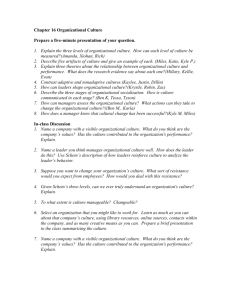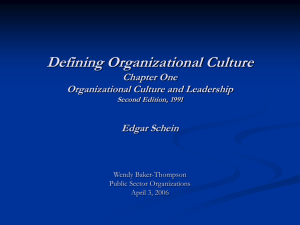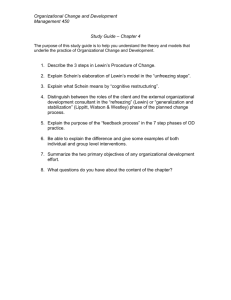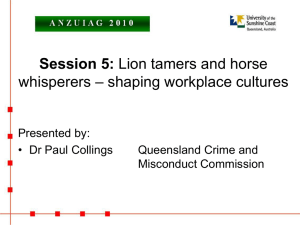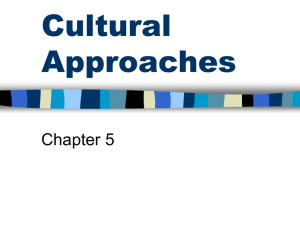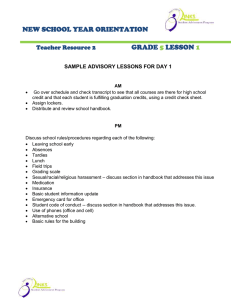Sense and Nonsense about Culture ... Climate by Professor Edgar H. Schein
advertisement
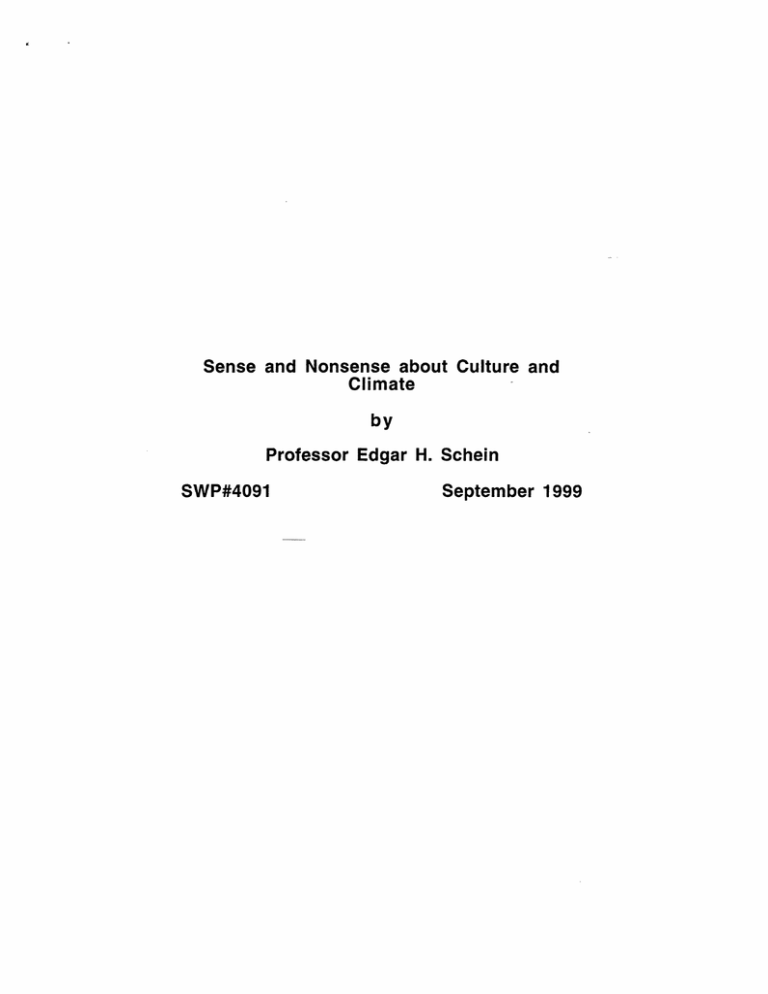
Sense and Nonsense about Culture and Climate by Professor Edgar H. Schein SWP#4091 September 1999 Sense and Nonsense about Culture and Climate Edgar H. Schein MIT Sloan School of Management Writing some comments for a handbook of this scope is a formidable task. But then, the climate/culture arena poses formidable challenges to us both intellectually and empirically. Having struggled with both issues since the early 1980's I want to make some general comments and try to clarify several issues. Why is it Important to differentiate Culture from Climate? On the practical level, culture and climate as organizational descriptors are on the rise. More and more managers in organizations are talking about changing their culture, creating a new culture, figuring out the impact of their culture, or preserving their culture. When one examines what they are actually talking about, much of it has to do with what we would and should call climate. Culture in popular managerial parlance usually refers to how people feel about the organization, the authority system, and the degree of employee involvement and commitment, the "soft" stuff, all of which refers more to climate than culture. Managers need to learn that where culture may matter most is in its impact on the so-called "hard" stuff like strategy and structure. Most managers are quite blind to the fact that their strategy and structure are dominated by cultural assumptions and that a history of success and failure hardwires these cultural assumptions into their thinking. © Schein, E.H. Commentary for Handbook of Culture and Climate. (1999) 1 Much of the confusion about the impact of culture could be reduced if we were clearer about 1) whether or not we are trying to change the climate and 2) how the underlying cultural assumptions would aid or inhibit that change process. Creating a climate of teamwork and openness is a common goal nowadays, but it is the rare company that figures out how cultural assumptions about individualism, about managerial prerogatives and about respect for authority based on past success may make teamwork and openness virtually impossible. The structure of the reward system in most U.S. organizations is likely to be so completely individualistic that it should be no surprise that even a well-conceived and highly motivating program of team building has minimal and only temporary results. Recall how quality circles failed in the U.S. not because workers don't care about quality, but because workers did not want to sit around in groups to talk about it. The Singapore Economic Development Board has figured out how to deal with this issue by defining individual managerial potential in terms of the "ability to create a team." So they still reward individuals, but they reward those individuals who have a track record of being able to attract others to work with them (Schein, 1996). The point is that they realized that the culture is embedded in the reward system and it is at that level that things have to be examined and, if necessary, changed. The resulting "climate" of teamwork and the effectiveness of project teams is striking in that organization. © Schein, E.H. Commentary for Handbook of Culture and Climate. (1999) 2 The second reason for bothering with this distinction is empirical. It seems obvious to me that organizations have climates that are immediately felt when one enters them. Climate is embedded inthe physical look of the place, the emotionality exhibited by employees, in the experiences of the visitor or new employee upon entry, and in a myriad of other artifacts that are seen, heard, and felt. It is equally obvious that climate does not explain itself. We need other variables to explain why different organizations feel different. My own resolution of this dilemma is to define climate as a cultural artifact resulting from espoused values and shared tacit assumptions. To fully understand climate one must dig deeper and examine values and assumptions. In other words, to fully understand what goes on in organizations and why it happens in the way it does one needs several concepts. Climate and culture, if each is carefully defined, then become two crucial building blocks for organizational description and analysis. How should we define and think about "culture?" A chronic issue in conceptualizing "culture" seems to be whether to think of culture as a "state" or static property of a given group/organization, or whether to think of culture as a human process of constructing shared meaning that goes on all the time. Culture creation from this second perspective can, in fact, be viewed as one of the unique characteristics of humans, being based on our © Schein, E.H. Commentary for Handbook of Culture and Climate. (1999) 3 capacity for self and other consciousness. The answer is, of course, that both meanings have utility for theory construction. I would propose that a useful way to think about this issue is to take a cue from the anthropologist Marshall Sahlins (1985) who argues that one cannot really understand certain social phenomena without understanding both the historical events and the cultural meanings attributed by the actors to those events. While it is undeniably true that we produce culture through perpetual enactment and sense making, it is equally true that the actors in those same social events bring to them some prior meanings, stereotypes, and expectations that can only be understood in a historical context. Culture production in the enactment sense, then, is either the perpetuation or change of some prior state, which can be thought of as the culture up to that point. And one can describe that culture as if it were a "state" of the existing system, even as one knows that the system is dynamic and perpetually evolving. The direction of that evolution will be a product of several forces: 1)technological and physical changes in the external environment; 2) changes in the internal dynamics of the social system; and 3) historical circumstances that are fortuitous or serendipitous. For example, let me offer my oversimplified summary of Sahlins' very sophisticated analysis of the death of Captain Cook at the hand of the Hawaiians. He notes several of these forces as they evolved historically. Because Captain Cook was viewed as a God (as predicted in the Hawaiian mythology), the sexual favors offered to his sailors by the Hawaiian women were viewed as gifts and as © Schein, E.H. Commentary for Handbook of Culture and Climate. (1999) 4 opportunities to relate to the divine. The sailors' cultural background defined this as a version of prostitution, however, for which they felt they should pay. When they offered the women something in exchange for the sex, the women asked for something that was scarce in the society, namely metal. Once the loose metal on board the ships had been used up, the sailors began to pull nails from the ship itself, weakening it structurally. Hence, when Captain Cook set sail he discovered that the ships needed repair and ordered a return to harbor. In Hawaiian mythology a God returning under these circumstances had to be ritually killed. At the same time Hawaiian social structure was undergoing change and became permanently altered because the subordinate role of women in the society was altered by their ability to acquire metal, a scarce resource that gave them social power. When one contemplates this wonderful analysis it appear pointless to argue whether culture can be viewed as a state of the system-clearly there was a culture in Hawaii and a different culture on board the British ship-or as a process of enactment--clearly the interaction of these two cultures produced events that had a profound impact on both of these cultures. For me the major lesson is that when we have access to historical data we should use it. When we analyze organizational cultures we should reconstruct their histories, find out about their founders and early leaders, look for the critical defining events in their evolution as organizations and be confident that when we have done this we can indeed describe sets of shared assumptions that derive from common © Schein, E.H. Commentary for Handbook of Culture and Climate. (1999) 5 experiences of success and shared traumas. And we can legitimately think of these sets of assumptions as "the culture" at a given time. That description will include sub-cultures that may be in conflict with each other, and there may be sub-units that have not yet had enough shared experience to have formed shared common assumptions. In other words, culture as a state, does not have to imply unanimity or absence of conflict. There can be some very strongly shared assumptions and large areas of conflict and/or ambiguity (Martin, 1992) within a given cultural state. At the same time, we can study the day to day interactions of the members of an organization with each other and with members of other organizations to determine how given cultural assumptions are reinforced and confirmed, or challenged and disconfirmed. We can analyze the impact of these perceptual interactive events in order to understand how cultures evolve and change. This process could be especially productive in mergers, acquisitions and joint ventures of various sorts. For example, Faure (1999) analyzes the negotiation tactics that occur in the various joint ventures that the Chinese have launched with non-Chinese partners, noting that for such a venture to succeed the partners to be must sometimes develop agreement on as many as 150 or more separate items. Whether one chooses to focus one's cultural research on building typologies of cultural "states," categories that freeze a given organization at a given point in time, or on analyzing the moment to moment interactions in which © Schein, E.H. Commentary for Handbook of Culture and Climate. (1999) 6 members of a given social system attempt to make sense of their experience and, in that process, reinforce and evolve cultural elements, becomes a matter of choice. Both are valid methodologies and in practice they should probably be combined, or one should choose a research method that suits the problems that the researcher is trying to solve. The Clinical Research Model for Studying Culture I have learned the most about culture when I have been involved as a consultant in trying to help an organization deal with specific issues on which they needed some help. The issue here is that in the normal flow of things cultural data are unintentionally concealed; the "natives" are not conscious of what it is that they take for granted. The researcher then has the problem of how to observe phenomena that occur at that level without, at the same time, upsetting the natives by delving into areas that may be defined by them as private, or even unwittingly intervening in those cultures by raising questions that the natives may never have thought about. Anthropologists have solved this problem by living in the groups that they are attempting to study, but this is very time consuming and requires great care so as not to influence the culture unduly. An alternative that has been given far too little attention academically is to draw observations and build theory from the data that are revealed when people ask for help (Schein, 1987, 1993). This tradition has worked well in studying personality in that the therapists whether psychoanalysts, behavior modification © Schein, E.H. Commentary for Handbook of Culture and Climate. (1999) 7 specialists, or gestalt psychologists have inevitably been able to see into deeper layers of the personality just through their diagnostic and intervention efforts. For living systems, Lewin's dictum that "you cannot really understand a system until you try to change it" is an absolutely valid principle of research. To build variables from these deeper insights seems like a very appropriate way to study living systems and that applies especially to complex systems like groups and organizations. There is a strong tradition of applied anthropology built around participant observation in the works of Mayo & Roethlisberger, Whyte, Dalton, Hughes, Becker, and Goffman. Recent examples would be Van Maanen's (1973, 1988) studies of police departments and Disney theme parks, Zuboff's "Inthe Age of the Smart Machine," (1988), Kunda's "Engineering Culture," (1992) and Thomas's "What Machines Can't Do" (1994). What all of these studies have in common is the reliance on participant observation. What is insufficiently spelled out in these studies, however, is how the observer got into the system in the first place and why he or she was tolerated and given data. There are basically three routes into the organization-1i) Infiltration where the participant observer becomes a true insider; 2) a formal research role agreed to by the insiders; and 3) a formal clinical role where the insider asks the outsider to come into the organization as a helper/consultant. I want to compare the pro's and con's of these three roles for the study of culture. In the infiltration model the cultural artifacts are very salient and the newcomer feels them immediately. © Schein, E.H. Commentary for Handbook of Culture and Climate. (1999) 8 However, just feeling them does not enable the researcher to decipher them, and there is a danger of projecting the meanings of one's own culture onto another culture. The ethnographic solution is to remain in the system long enough to figure out what things mean or seek informants with whom a new kind of relationship is forged. In building that relationship the researcher must have something to offer, usually in the form of feedback of the results. However this is rarely enough to motivate real collaboration on the part of the informant. My hypothesis would be that only when the members of the culture see the ethnographer as helpful in the here and now, do they really open up and tell the researcher what things really mean. I believe the same is true for the researcher who negotiates entry by promising feedback. He or she is allowed limited entry but is not really told what things mean and what is really going on until insiders feel comfortable that the researcher will be helpful rather than harmful to them. "Gaining entry" then becomes functionally very similar to evolving a clinical relationship with the client where the goal is organizational improvement of some sort. What distinguished the clinician/consultant at the outset is that the problem or issue to be addressed is initially defined by the client not the researcher. The client is willing to pay for a service and this creates a different psychological contract-on the one hand the area of inquiry is delimited initially by the client, but, on the other hand, the consultant is licensed to ask deeper questions, to dig into dirty laundry because that is necessary to doing the job. As © Schein, E.H. Commentary for Handbook of Culture and Climate. (1999) 9 I have argued elsewhere (Schein, 1999a) the clinician still has to worry about establishing a relationship of trust in which the inquiry process becomes a shared intervention between the consultant and the client. The conclusion I draw from this analysis is that any form of inquiry into organizational culture, whether researcher or client initiated will only be successful in digging out the deeper layers of the culture if the inquirer and the client system form a mutually trusting and rewarding relationship. Research and clinical work begin to merge, no matter how they were initiated. If the research is done without the direct involvement of the organization, it is doubtful that the deeper layers of the culture can be deciphered (Schein, 1999b). Can Cultures be categorized or profiled? All culture and climate researchers start with some mental models of what they are looking for, based on their own education and empirical predilections. So we should not kid ourselves that we can go into an organization as a tabula rasa and just let the culture "speak" to us. Even how we experience the artifactual level, what we see and hear as we enter an organization is biased by the perceptual and conceptual filters we bring to the situation. The issue, then, is not whether or not we will start with a priori dimensions in studying the organization but, rather, how broadly we will cast the net and what kind of theoretical model we will start with. © Schein, E.H. Commentary for Handbook of Culture and Climate. (1999) 10 My prime objection to questionnaires as research tools for the study of culture is that they force us to cast the theoretical net too narrowly. Even the 500 plus item personality scales such as the MMPI have to decide ahead of time what kinds of items to write and thereby limit the domain of inquiry. The advantage of the ethnographic or clinical research method is that we can consciously train ourselves to minimize the impact of our own models and to maximize staying open to new experiences and concepts we may encounter. In the end we may well sort those experiences into the existing categories we already hold. But at least we will have given ourselves the opportunity to discover new dimensions and, more importantly, will have a better sense of the relative salience and importance of certain dimensions within the culture. The issue of salience is very important because not all the elements of a culture are equally potent in the degree to which they determine behavior. The more open group oriented inquiry not only reveals how the group views the elements of the culture, but, more importantly, tells us immediately which things are more salient and, therefore, more important as determinants. As to the categories themselves, it seems to me that most of the questionnaires that have been developed draw their initial dimensions from narrow socio-psychological theories and ignore broader models developed by anthropologists and sociologists. Even functionalism narrows one's scope somewhat, but at least an effort to define all of the functions that cultural solutions must address forces us to cast the net widely. Inthis regard I have © Schein, E.H. Commentary for Handbook of Culture and Climate. (1999) 11 found it empirically useful to start with a broad list of "survival functions"-what any group must do to survive in its various environments and fulfill its primary task, and "internal integration functions"-what any group must do to maintain itself as a functioning system. This distinction is entirely consistent with a long tradition of empirical research in group dynamics that always turns up two critical factors in what groups do-1) task functions and 2) group building and maintenance functions. Ancona and others have pointed out that we must add a third set to these two-boundary maintenance functions (Ancona, 1988). Task and boundary maintenance functions are my external survival issues, and group building and maintenance functions are my internal integration issues. We may then construct different lists of what specific dimensions of behavior, attitude, and belief we will look for in each domain but at least we have a model that forces us to cast the net widely, and a reminder that culture is for the group the learned solution to all of its external and internal problems. If we then look a little deeper, drawing again on anthropology and sociology, we find broad cultural variations around deeper more abstract issues that link less with social psychology and more with cognitive psychology. How do we fundamentally view the world and our relationship to it? How does our language create perceptual and thinking patterns that differ fundamentally? One of the first lessons of Anthropology 1 was that the Eskimos have 30 kinds of snow in their vocabulary and this reflects different conceptual and perceptual skills than someone living in the tropics would have. © Schein, E.H. Commentary for Handbook of Culture and Climate. (1999) 12 Inthis regard it is puzzling that the seminal work of Florence Kluckhohn and Fred Strodtbeck (1961) on comparative value systems has not led to more culture research. In their effort to compare the cultures of Native Americans, Anglos, and Hispanics in the American Southwest, they developed a number of very useful "deep" dimensions reflecting that nature of human nature, the relationship of humans to their surrounding environment, the nature of human activity, the nature of human relationships, and basic orientation toward time. Also underutilized is the work of England (1975) on managerial values that deals specifically with how in a given culture one arrives at "truth." If one combines these dimensions with some of the dimensions identified by Edward Hall (1966, 1976, 1983) on concepts of space and spatial relationships, and with more recent concepts about the nature of the "self"' in different cultures, one has a pretty good template of what culture covers at this deeper level. I do not see how any questionnaire, no matter how well designed could even begin to get at some of these dimensions. However, in group interviews of representative samples of "natives" one can observe and ask about various of these dimensions if one has been given license to do so because one is perceived to be helping the natives solve some problem. "Culture" questionnaire scores do correlate with various indexes of organizational performance but these measures are more appropriately measures of climate than measures of culture. Since climate is an artifact of culture, such scores may measure some of the manifestations of underlying © Schein, E.H. Commentary for Handbook of Culture and Climate. (1999) 13 cultural assumptions but since they do not empirically check what those deeper assumptions are, it is not clear what the correlations are based on. For examp!e, certain aspects of climate can reflect a coercive management and the effectiveness could be due to the potency of management rather than the particular norms being enforced. To deal with this issue, researchers often ask on the questionnaire what employees would like as desired norms and test whether movement over time toward those norms correlates with organizational effectiveness. Some evidence exists along these lines, but there is a further problem. Unless the underlying assumptions are checked it is not possible to determine ahead of time whether or not it will be possible for the organization to move in the direction of the new norms. It may be that the error variance in the correlation hides an important empirical fact-that movement toward certain desired norms is aided or constrained by the pattern of underlying assumptions. An ideal research design would measure the present and desired norms, and then check in the underlying assumption set (through group interviews that get at assumptions) why discrepancies exist between the present state and the desired state in the first place. It is the causes of those discrepancies that management needs to understand in order to determine what kind of culture change program to launch to achieve greater organizational effectiveness. A further point is that management should not seek to change culture, but to change effectiveness. Only if it can be shown that the culture is actually a © Schein, E.H. Commentary for Handbook of Culture and Climate. (1999) 14 constraint should one launch culture change programs. To demonstrate that culture is a constraint requires, however, more than a questionnaire study. When one digs for underlying assumptions one typically finds that some cultural assumptions actually will help achieve the kind of effectiveness desired, and that only some elements of the culture may be discovered to be constraints. Since culture change is intrinsically difficult, time consuming, and anxiety provoking it is far more desirable to work with supportive assumptions to achieve whatever new norms are desired. Can the Culture and Climate concepts be useful to the practitioner? Climate can only be changed to the degree that the desired climate is congruent with the underlying assumptions. One cannot create, for example, a climate of teamwork and cooperation if the underlying assumptions in the culture are individual and competitive, because those assumptions will have created a reward and control system that encourages individual competitiveness. One cannot create a climate of participation and empowerment if the underlying assumptions in the culture are that subordinates should do what they are told and should expect their bosses to know what they are doing. One cannot create a climate of openness if the history of the company has been to punish the messenger for bad news. All too often change programs fail because they do not consider what the underlying culture is. Inother words, surveying climate and © Schein, E.H. Commentary for Handbook of Culture and Climate. (1999) 15 specifying a desired climate is not enough. One must analyze the underlying cultural assumptions. If culture and climate are to become practical usable concepts, the practitioner will have to learn how to do culture assessments as part of any change program. Articulating new visions and new values is a waste of time if they are not calibrated against the existing assumptions and values. If such assessments are done, it is usually found that there are elements in the culture that can be used positively to create new ways of working that are more effective, and that is far preferable to "changing" the culture. In this regard, I agree completely with Cooperrider and others who have developed the concepts and methods of "appreciative inquiry" (1987, 1990). It is better to build on what is working than to obsess about what is not working. It is easier to evolve the culture than to change it. Cross-Cultural Communication: The Role of Dialogue Cultures exist at the regional and national level, we have cultures at the industry or institutional level, we have cultures at the organizational level, and we have occupational cultures and sub-cultures within organizations based on functions and tasks. Part of the reason organizations do not work well, part of the reason we have wars, and part of the reason we have difficulties reaching consensus on major global problems such as maintaining a healthy environment is that we cannot communicate very well across cultural boundaries. We have © Schein, E.H. Commentary for Handbook of Culture and Climate. (1999) 16 excellent data that show how differently different groups perceive their environments based on different shared tacit assumptions, but we have very few tools for helping people to improve their communication across those boundaries. The recent emphasis on "Dialogue" (Isaacs, 1993, 1999; Schein, 1993) may help in that dialogue is focused on getting acquainted with one's own assumptions. We cannot appreciate another culture if we are not aware of our own cultural filters. Dialogue theory assumes that each human has his own set of assumptions from which he or she operates, and when such assumptions are shared across a group with shared experience we have not only the presence of the assumptions as filters but the motivation to hold on to those assumptions as a way of expressing our membership in the group. If we are to gain any understanding of another group's assumptions we must get into a communication mode that legitimizes self-examination and acknowledges that perception and thought are anything but objective. It would therefore be highly instructive for both researchers and practitioners to form dialogue groups and begin to examine in a group context what their own assumptions are. Not only will this reveal the subtle operation of cultural forces but will make visible where different assumptions lead to different behaviors and often conflicts. Once assumptions are surfaced and stated, mutual understanding increases and the basis exists for finding common ground. I hope that this handbook will stimulate more people to think about culture and to seek a deeper understanding of its operation in ourselves and in others. © Schein, E.H. Commentary for Handbook of Culture and Climate. (1999) 17 References --Ancona, D. G. (1988) "Groups in organizations: Extending laboratory models. In C. Hendrick (ed.) Annual Review of Personality and Social Psychology: Group and Intergroup Processes. Beverly Hills, CA.: Sage. --Cooperrider, D. L. & Srivastva, S. (1987) "Appreciative inquiry into organizational life." In R. W. Woodman & W. A. Pasmore (eds.) Research in Organizational Change and Development. Vol. 1. Greenwich, Conn.: JAI Press, pp. 129-169. --Cooperrider, D. L. (1990) "Positive image, positive action: The affirmative basis of organizing." In S. Srivastva & D.L. Cooperrider (Eds.) Appreciative management and leadership. San Francisco: Jossey-Bass. pp. 91-125. -- England, G. (1975). The manager and his values. N.Y.:Ballinger. -- Faure, --Hall, E. T. (1966) The hidden dimension. N.Y.: Doubleday. --Hall, E. T. (1976) Beyond culture. N. Y.: Doubleday. --Hall, E. T. (1983) The dance of life. N. Y.: Doubleday. -- Isaacs, W. N. (1993) Taking flight: Dialogue, collective thinking, and organizational learning. Organizational Dynamics, Winter, 24-39. -- Isaacs, W. N. (1999) Thinking together. (inpress) -- Kluckhohn, F. R. & Strodtbeck, F. L. (1961). Variations in value orientations. Harper. --Kunda, G. (1992). Engineering culture. Philadelphia: Temple Univ. Press. --Martin, J. (1992). Cultures in organizations. Oxford Univ. Press. -- Sahlins, M. (1985) Islands of history. U.of Chicago Press. © Schein, E.H. Commentary for Handbook of Culture and Climate. (1999) 18 -- Schein, E. H. (1987a) The clinical perspective in fieldwork. Newbury Park, CA.: Sage. -- Schein, E. H. (!993b) On Dialogue, Culture, and Organizational Learning. Organizational Dynamics, Autumn, 22, 40-51. --Schein, E. H. (1993d) Legitimating clinical research in the study of organizational culture. Journal of Counseling and Development, 71, 703-708. --Schein, E. H. (1996) Strategic pragmatism: The culture of Singapore's Economic Development Board. Cambridge, MA.: MIT Press --Schein, E. H. (1999a). Process consultation revisited: Building thehelping relationship. Reading, MA.: Addison-Wesley-Longman. --Schein, E. H. (1999b). The corporate culture survival guide. Jossey-Bass. --Thomas, R. (1994) What machines can't do. Univ. of California Press. --Van Maanen, J. (1973) Observations on the making of policemen. Human Organization, 32, 407-18.--Van Maanen, J. (1988) Tales of the field: On writing ethnography. Chicago: U. of Chicago Press. --Zuboff, S. (1988). Inthe age of the smart machine. N.Y.: Basic Books. © Schein, E.H. Commentary for Handbook of Culture and Climate. (1999) 19
